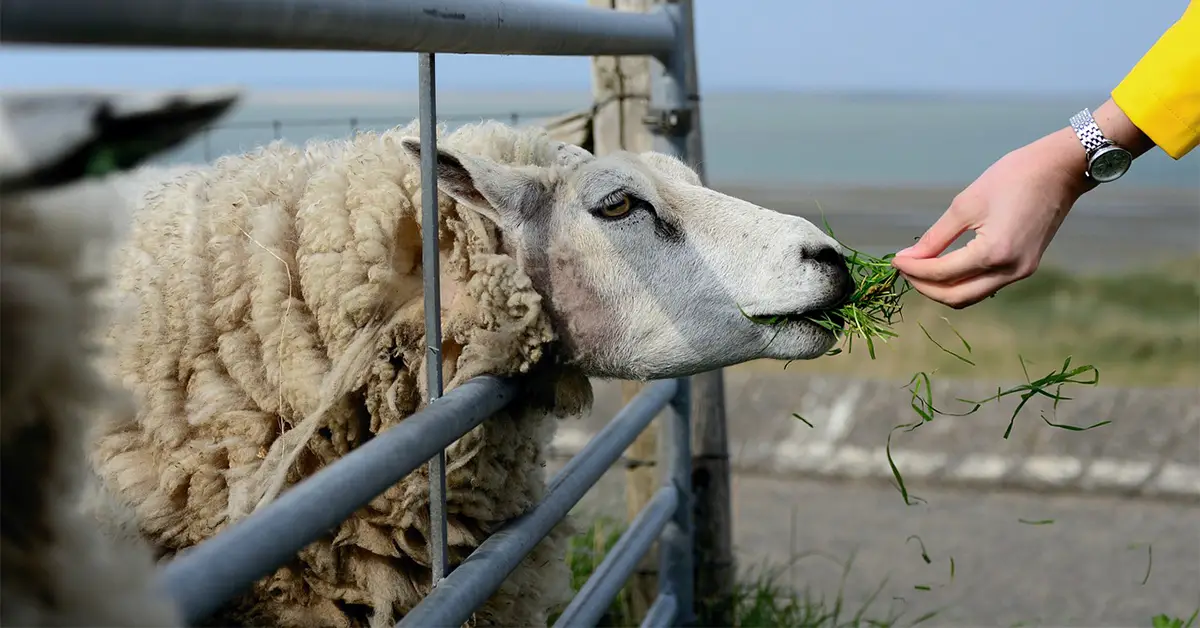The amount of wool produced by a sheep can vary depending on the breed, genetics, and environmental factors. On average, a mature sheep produces anywhere between 2 to 30 pounds (0.9 to 13.6 kilograms) of wool per year. However, some specialized breeds can yield even higher amounts of wool.
The Wool-Producing Sheep Breeds
There are several sheep breeds known for their wool production. Here are some of the most well-known wool-producing sheep breeds:
- Merino: Merino sheep are highly regarded for their fine, soft wool. They produce a dense fleece with excellent crimp and elasticity, making their wool suitable for high-quality garments and textiles.
- Rambouillet: Rambouillet sheep, also known as French Merinos, produce fine and dense wool similar to the Merino breed. They are highly adaptable and can thrive in different climates, making them popular in many countries.
- Cormo: Cormo sheep are a relatively newer breed developed in Australia. They produce soft, fine wool with a high crimp. The wool is prized for its warmth and versatility.
- Corriedale: Corriedale sheep are a dual-purpose breed known for both their meat and wool. They produce a medium-wool fleece that is versatile and can be used for a wide range of applications, including clothing and blankets.
- Border Leicester: Border Leicester sheep are renowned for their long, lustrous wool with good crimp and handle. The wool is often used for blending with other fibers to add strength and luster to yarns and fabrics.
- Lincoln: Lincoln sheep have one of the heaviest and longest wool fleeces among sheep breeds. Their coarse wool is highly lustrous and has a long staple length, making it suitable for heavy-duty applications like rugs and upholstery.
- Romney: Romney sheep produce a medium-wool fleece that is durable and has good luster. The wool is often used in the production of yarns, fabrics, and outerwear.
- Bluefaced Leicester: Bluefaced Leicester sheep have a lustrous, longwool fleece. Their wool is highly valued in the textile industry, particularly for making fine, lightweight garments.
Factors Influencing Wool Production
Several factors can influence wool production in sheep. Here are some of the key factors:
- Genetics: The genetic makeup of a sheep plays a significant role in determining its wool production potential. Different sheep breeds have varying wool characteristics, such as fiber diameter, crimp, staple length, and overall fleece quality. Selective breeding programs are often implemented to improve wool traits and increase production.
- Nutrition: Adequate nutrition is crucial for optimal wool production. Sheep require a balanced diet that includes sufficient protein, energy, minerals, and vitamins. Deficiencies in any essential nutrients can negatively impact wool growth and quality. Providing access to good pasture, quality hay or forage, and appropriate supplements can help ensure proper nutrition for the sheep.
- Health and Parasite Control: Sheep that are in good health and free from parasites tend to have better wool production. Internal and external parasites can cause stress, discomfort, and damage to the sheep’s skin and fleece. Regular deworming, vaccinations, and proper herd health management practices are essential for maintaining healthy sheep and promoting wool growth.
- Shearing: Regular and proper shearing is necessary to maximize wool production. Shearing removes the fleece, stimulates the skin, and promotes the growth of new wool fibers. Shearing at appropriate intervals helps prevent excessive wool breakage, matting, and other issues that can affect wool quality and yield.
- Environmental Factors: Environmental conditions can impact wool production. Extreme temperatures, humidity, and weather fluctuations can stress sheep and affect their overall well-being, including wool growth. Providing adequate shelter, proper ventilation, and managing heat or cold stress can help maintain optimal wool production.
- Management Practices: Effective sheep management practices, such as providing clean and comfortable bedding, proper sanitation, and good flock handling techniques, can contribute to wool production. Reducing stress levels in sheep through careful management can positively impact their overall health and wool production.
Understanding the Wool Growth Cycle
The wool growth cycle refers to the process by which sheep produce and replace their wool. It consists of several stages:
- Anagen Phase (Active Growth): This is the primary phase of wool growth. During this stage, specialized cells in the sheep’s skin called follicles actively produce new wool fibers. The length of the anagen phase varies depending on factors such as breed, genetics, and environmental conditions.
- Catagen Phase (Transition): After the anagen phase, the follicles enter the catagen phase. In this stage, the follicles undergo a transition period where the production of new wool fibers slows down. The duration of the catagen phase is relatively short.
- Telogen Phase (Resting): The telogen phase is a resting phase where the follicles are dormant. No active growth occurs during this stage. The length of the telogen phase can vary but is typically longer in comparison to the other phases.
- Shedding or Shearing: Eventually, the old wool fibers are shed or removed through shearing. This process allows for the removal of the mature wool and prepares the sheep for the next cycle of wool growth.
- Regeneration: Following shedding or shearing, the follicles re-enter the anagen phase, initiating the growth of a new fleece. The cycle repeats itself, and the sheep begins to produce a fresh layer of wool.
The duration of the wool growth cycle can be influenced by factors such as breed, age, nutrition, and season. Typically, sheep experience a natural increase in wool growth during the spring months, known as the “spring flush.” This is when wool growth is at its peak due to increased daylight hours and improved grazing conditions.
Measuring and Estimating Wool Yield
Measuring and estimating wool yield in sheep involves various methods to determine the quantity and quality of wool produced. Here are some common approaches:
- Weighing the Fleece: The most straightforward method is to weigh the entire fleece obtained from shearing. This provides a direct measurement of the wool yield. The fleece weight is typically recorded in pounds or kilograms.
- Fleece Weight per Head: By weighing the fleece and knowing the number of sheep in a flock, you can calculate the average fleece weight per head. This allows for estimating the wool yield per individual sheep.
- Fleece Weight as a Percentage of Body Weight: Another way to estimate wool yield is to calculate the fleece weight as a percentage of the sheep’s body weight. This method takes into account the size and condition of the animal. For example, if a sheep weighs 100 pounds and its fleece weighs 10 pounds, the fleece yield would be 10% of the body weight.
- Fleece Density: Fleece density refers to the number of wool fibers per unit area on the sheep’s body. It can be assessed by taking small samples from different parts of the fleece and counting the fibers under a microscope. Higher fleece density usually indicates a greater amount of wool produced.
- Fiber Diameter: The diameter of wool fibers, often measured in microns, is an important indicator of wool quality and can provide insights into wool yield. Finer fibers are generally more desirable and can command higher prices in the market.
- Visual Assessment: Experienced wool growers and evaluators can visually assess the quality and quantity of wool by considering factors such as crimp, staple length, cleanliness, and overall appearance. While this method may not provide precise measurements, it can give a good estimation of the wool yield and quality.
Average Wool Yield per Sheep by Breed
The average wool yield per sheep can vary significantly depending on the breed, genetics, and environmental factors. Here is a general overview of the average wool yield for some common sheep breeds:
- Merino: Merino sheep are known for their high-quality wool. On average, a mature Merino sheep can produce around 10 to 30 pounds (4.5 to 13.6 kilograms) of wool per year. However, certain strains of Merino sheep bred specifically for wool production can yield even higher amounts.
- Rambouillet: Rambouillet sheep, also known as French Merinos, have a wool yield similar to Merinos. They can produce an average of 10 to 30 pounds (4.5 to 13.6 kilograms) of wool per year.
- Columbia: Columbia sheep are a dual-purpose breed, bred for both meat and wool. They have a medium-wool fleece and can produce around 8 to 15 pounds (3.6 to 6.8 kilograms) of wool per year.
- Corriedale: Corriedale sheep are another dual-purpose breed with a medium-wool fleece. They typically produce around 8 to 15 pounds (3.6 to 6.8 kilograms) of wool per year.
- Border Leicester: Border Leicester sheep have a long, lustrous wool fleece. They can produce approximately 10 to 18 pounds (4.5 to 8.2 kilograms) of wool per year.
- Romney: Romney sheep produce a medium-wool fleece and can yield around 10 to 20 pounds (4.5 to 9.1 kilograms) of wool per year.
- Lincoln: Lincoln sheep have one of the heaviest and longest wool fleeces among sheep breeds. They can produce an average of 12 to 20 pounds (5.4 to 9.1 kilograms) of wool per year.
Conclusion
In conclusion, the wool yield per sheep can vary depending on several factors, including the breed, genetics, nutrition, health, and management practices. Sheep breeds known for their wool production, such as Merino, Rambouillet, Columbia, Corriedale, Border Leicester, Romney, and Lincoln, generally have varying average wool yields

